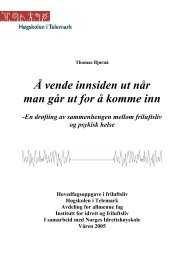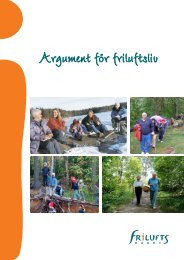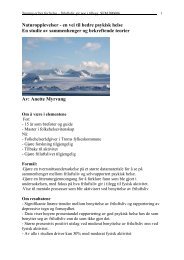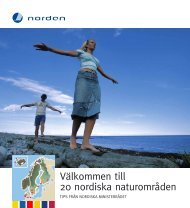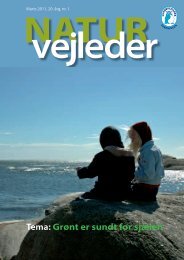Green Care: A Conceptual Framework - Frisk i naturen
Green Care: A Conceptual Framework - Frisk i naturen
Green Care: A Conceptual Framework - Frisk i naturen
You also want an ePaper? Increase the reach of your titles
YUMPU automatically turns print PDFs into web optimized ePapers that Google loves.
landscape and aesthetics, recreation and amenity, water accumulation and<br />
supply, nutrient recycling and fixation, wildlife habitats, storm protection<br />
and flood control as well as carbon sequestration (Dobbs and Pretty,<br />
2004). These public services gained from land have been the focus of the<br />
Millennium Ecosystem Assessment (2005) and Defra (2007).<br />
In the past, the focus has been on the negative externalities of agriculture:<br />
water pollution (from pesticides, fertilisers and soil, from farm waste,<br />
Cryptosporidium from livestock etc); the loss of landscape (hedgerows,<br />
picture postcard fields) and biodiversity (wildlife, farmland birds etc.);<br />
the spread of food-borne diseases (salmonella, BSE etc.) and gaseous<br />
emissions (methane from livestock) (Pretty et al, 2001). However, the<br />
concept of multifunctionality in agriculture switches the focus onto the<br />
positive side effects of farming.<br />
This has been supported by the Curry Commission (2002), which<br />
recommended that subsidy payments under the Common Agricultural<br />
Policy (CAP) should be decoupled from production. Thus establishing the<br />
principle that agriculture and land management also have many positive<br />
side-effects, contributing to public goods such as biodiversity, landscape<br />
aesthetics, water quality, carbon sequestration and so on (Dobbs and Pretty,<br />
2004)<br />
The multifunctional nature of the services provided therefore gives a<br />
multifunctional value for the land. From a review of the current literature<br />
and previous work on the multifunctionality of land (Pretty et al, 2000;<br />
Dobbs and Pretty, 2004; Pretty et al, 2008; Hine et al, 2008b), eight key<br />
services produced by the land have been identified (Table 7.1). Many of the<br />
services and functions highlighted in Table 7.1 have gone unrecognised in<br />
the past, or because they have contributed to public goods or services they<br />
have not had a cost or value assigned, and so have tended to receive little<br />
attention.<br />
107









